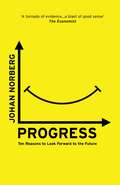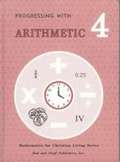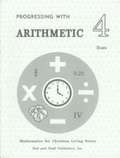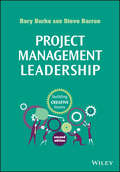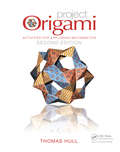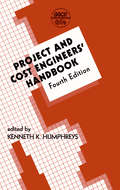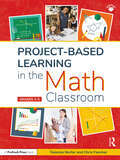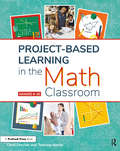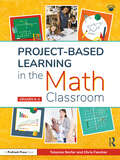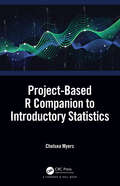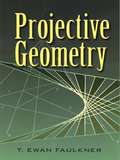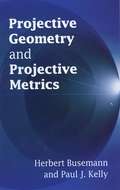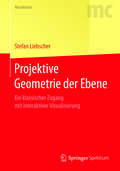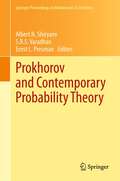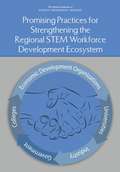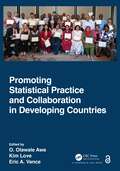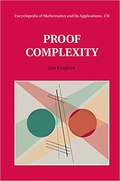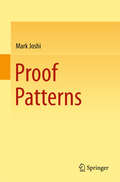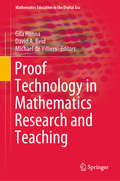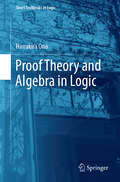- Table View
- List View
Progress: Ten Reasons to Look Forward to the Future
by Johan NorbergA Book of the Year for The Economist and the Observer Our world seems to be collapsing. The daily news cycle reports the deterioration: divisive politics across the Western world, racism, poverty, war, inequality, hunger. While politicians, journalists and activists from all sides talk about the damage done, Johan Norberg offers an illuminating and heartening analysis of just how far we have come in tackling the greatest problems facing humanity. In the face of fear-mongering, darkness and division, the facts are unequivocal: the golden age is now.
Progresses in Artificial Intelligence and Neural Systems (Smart Innovation, Systems and Technologies #184)
by Anna Esposito Marcos Faundez-Zanuy Francesco Carlo Morabito Eros PaseroThis book provides an overview of the current advances in artificial intelligence and neural nets. Artificial intelligence (AI) methods have shown great capabilities in modelling, prediction and recognition tasks supporting human–machine interaction.At the same time, the issue of emotion has gained increasing attention due to its relevance in achieving human-like interaction with machines. The real challenge is taking advantage of the emotional characterization of humans’ interactions to make computers interfacing with them emotionally and socially credible.The book assesses how and to what extent current sophisticated computational intelligence tools might support the multidisciplinary research on the characterization of appropriate system reactions to human emotions and expressions in interactive scenarios. Discussing the latest recent research trends, innovative approaches and future challenges in AI from interdisciplinary perspectives, it is a valuable resource for researchers and practitioners in academia and industry.
Progressing With Arithmetic Grade 4
by Lester Miller Timothy Conley Sandra BaumanThis hardcover textbook has 170 lessons, counting tests. Teaches the multiplication and division facts 10's-12's, long division, multiplying by 2-digit numbers, and checking. Reading problem skills include distance-rate-time, 2-step problems, using sketches, and identifying missing information. Also covers place value, decimals, Roman numerals, scale drawings, metric units of length, fractions, geometry, and graphs.
Progressing with Arithmetic Grade 4 Tests (Mathematics for Christian Living Series)
by Rod Staff PublishersThis is a test booklet for Grade 4 Math.
Project Management Leadership
by Steve Barron Rory BurkeProject Management Leadership is a comprehensive guide to the human factors involved in Project Management, in particular the leadership skills required to ensure successful implementation of current best practice. It provides the latest insights on team building, motivation, collaboration, and networking skills, and the way these can be harnessed to manage a successful project. Exercises and worked examples are provided throughout alongside a fully revised instructor manual.
Project Origami: Activities for Exploring Mathematics, Second Edition (AK Peters/CRC Recreational Mathematics Series)
by Thomas HullProject Origami: Activities for Exploring Mathematics, Second Edition presents a flexible, discovery-based approach to learning origami-math topics. It helps readers see how origami intersects a variety of mathematical topics, from the more obvious realm of geometry to the fields of algebra, number theory, and combinatorics. With over 100 new pages, this updated and expanded edition now includes 30 activities and offers better solutions and teaching tips for all activities.The book contains detailed plans for 30 hands-on, scalable origami activities. Each activity lists courses in which the activity might fit, includes handouts for classroom use, and provides notes for instructors on solutions, how the handouts can be used, and other pedagogical suggestions. The handouts are also available on the book’s CRC Press web page.Reflecting feedback from teachers and students who have used the book, this classroom-tested text provides an easy and entertaining way for teachers to incorporate origami into a range of college and advanced high school math courses.Visit the author’s website for more information.
Project and Cost Engineers' Handbook (Cost Engineering)
by Kenneth K. HumphreysMaking the specifics of a complex concern accessible and its handling quite manageable, this fourth edition of the Project and Cost Engineers' Handbook examines the variables associated with international projects and project risk analysis. It provides instruction on contingency planning, delves into ethical considerations, considers the imp
Project-Based Learning in the Math Classroom: Grades 3-5
by Chris Fancher Telannia NorfarProject-Based Learning in the Math Classroom: Grades 3–5 explains how to keep inquiry at the heart of mathematics teaching in the upper elementary grades. Helping teachers integrate other subjects into the math classroom, this book outlines in-depth tasks, projects and routines to support Project-Based Learning (PBL). Featuring helpful tips for creating PBL units, alongside models and strategies that can be implemented immediately, Project-Based Learning in the Math Classroom: Grades 3–5 understands that teaching in a project-based environment means using great teaching practices. The authors impart strategies that assist teachers in planning standards-based lessons, encouraging wonder and curiosity, providing a safe environment where mistakes can occur, and giving students opportunities for revision and reflection.
Project-Based Learning in the Math Classroom: Grades 3-5
by Chris Fancher Telannia NorfarProject-Based Learning in the Math Classroom: Grades 3–5 explains how to keep inquiry at the heart of mathematics teaching in the upper elementary grades. Helping teachers integrate other subjects into the math classroom, this book outlines in-depth tasks, projects and routines to support Project-Based Learning (PBL). Featuring helpful tips for creating PBL units, alongside models and strategies that can be implemented immediately, Project-Based Learning in the Math Classroom: Grades 3–5 understands that teaching in a project-based environment means using great teaching practices. The authors impart strategies that assist teachers in planning standards-based lessons, encouraging wonder and curiosity, providing a safe environment where mistakes can occur, and giving students opportunities for revision and reflection.
Project-Based Learning in the Math Classroom: Grades 6-10
by Chris Fancher Telannia NorfarProject-Based Learning in the Math Classroom explains how to keep inquiry at the heart of mathematics teaching and helps teachers build students' abilities to be true mathematicians. This book outlines basic teaching strategies, such as questioning and exploration of concepts. It also provides advanced strategies for teachers who are already implementing inquiry-based methods. Project-Based Learning in the Math Classroom includes practical advice about strategies the authors have used in their own classrooms, and each chapter features strategies that can be implemented immediately. Teaching in a project-based environment means using great teaching practices. The authors impart strategies that assist teachers in planning standards-based lessons, encouraging wonder and curiosity, providing a safe environment where failure occurs, and giving students opportunities for revision and reflection.Grades 6-10
Project-Based Learning in the Math Classroom: Grades K-2
by Chris Fancher Telannia NorfarProject-Based Learning in the Math Classroom: Grades K–2 explains how to keep inquiry at the heart of mathematics teaching in the elementary grades. Helping teachers integrate other subjects into the math classroom, this book outlines in-depth tasks, projects and routines to support Project-Based Learning (PBL). Featuring helpful tips for creating PBL units, alongside models and strategies that can be implemented immediately, Project-Based Learning in the Math Classroom: Grades K–2 understands that teaching in a project-based environment means using great teaching practices. The authors impart strategies that assist teachers in planning standards-based lessons, encouraging wonder and curiosity, providing a safe environment where mistakes can occur, and giving students opportunities for revision and reflection.
Project-Based Learning in the Math Classroom: Grades K-2
by Chris Fancher Telannia NorfarProject-Based Learning in the Math Classroom: Grades K–2 explains how to keep inquiry at the heart of mathematics teaching in the elementary grades. Helping teachers integrate other subjects into the math classroom, this book outlines in-depth tasks, projects and routines to support Project-Based Learning (PBL). Featuring helpful tips for creating PBL units, alongside models and strategies that can be implemented immediately, Project-Based Learning in the Math Classroom: Grades K–2 understands that teaching in a project-based environment means using great teaching practices. The authors impart strategies that assist teachers in planning standards-based lessons, encouraging wonder and curiosity, providing a safe environment where mistakes can occur, and giving students opportunities for revision and reflection.
Project-Based R Companion to Introductory Statistics: A Project-Based Approach using R
by Chelsea MyersProject-Based R Companion to Introductory Statistics is envisioned as a companion to a traditional statistics or biostatistics textbook, with each chapter covering traditional topics such as descriptive statistics, regression, and hypothesis testing. However, unlike a traditional textbook, each chapter will present its material using a complete step-by-step analysis of a real publicly available dataset, with an emphasis on the practical skills of testing assumptions, data exploration, and forming conclusions. The chapters in the main body of the book include a worked example showing the R code used at each step followed by a multi-part project for students to complete. These projects, which could serve as alternatives to traditional discrete homework problems, will illustrate how to "put the pieces together" and conduct a complete start-to-finish data analysis using the R statistical software package. At the end of the book, there are several projects that require the use of multiple statistical techniques that could be used as a take-home final exam or final project for a class. Key features of the text: Organized in chapters focusing on the same topics found in typical introductory statistics textbooks (descriptive statistics, regression, two-way tables, hypothesis testing for means and proportions, etc.) so instructors can easily pair this supplementary material with course plans Includes student projects for each chapter which can be assigned as laboratory exercises or homework assignments to supplement traditional homework Features real-world datasets from scientific publications in the fields of history, pop culture, business, medicine, and forensics for students to analyze Allows students to gain experience working through a variety of statistical analyses from start to finish The book is written at the undergraduate level to be used in an introductory statistical methods course or subject-specific research methods course such as biostatistics or research methods for psychology or business analytics. Author After a 10-year career as a research biostatistician in the Department of Ophthalmology and Visual Sciences at the University of Wisconsin-Madison, Chelsea Myers teaches statistics and biostatistics at Rollins College and Valencia College in Central Florida. She has authored or co-authored more than 30 scientific papers and presentations and is the creator of the MCAT preparation website MCATMath.com.
Projective Geometry
by Elisabetta Fortuna Roberto Frigerio Rita PardiniThis book starts with a concise but rigorous overview of the basic notions of projective geometry, using straightforward and modern language. The goal is not only to establish the notation and terminology used, but also to offer the reader a quick survey of the subject matter. In the second part, the book presents more than 200 solved problems, for many of which several alternative solutions are provided. The level of difficulty of the exercises varies considerably: they range from computations to harder problems of a more theoretical nature, up to some actual complements of the theory. The structure of the text allows the reader to use the solutions of the exercises both to master the basic notions and techniques and to further their knowledge of the subject, thus learning some classical results not covered in the first part of the book. The book addresses the needs of undergraduate and graduate students in the theoretical and applied sciences, and will especially benefit those readers with a solid grasp of elementary Linear Algebra.
Projective Geometry
by T. Ewan FaulknerThis text explores the methods of the projective geometry of the plane. Some knowledge of the elements of metrical and analytical geometry is assumed; a rigorous first chapter serves to prepare readers. Following an introduction to the methods of the symbolic notation, the text advances to a consideration of the theory of one-to-one correspondence. It derives the projective properties of the conic and discusses the representation of these properties by the general equation of the second degree. A study of the relationship between Euclidean and projective geometry concludes the presentation. Numerous illustrative examples appear throughout the text.
Projective Geometry and Projective Metrics (Dover Books on Mathematics #Volume 3)
by Herbert Busemann Paul J. KellyThe basic results and methods of projective and non-Euclidean geometry are indispensable for the geometer, and this book--different in content, methods, and point of view from traditional texts--attempts to emphasize that fact. Results of special theorems are discussed in detail only when they are needed to develop a feeling for the subject or when they illustrate a general method. On the other hand, an unusual amount of space is devoted to the discussion of the fundamental concepts of distance, motion, area, and perpendicularity.Topics include the projective plane, polarities and conic sections, affine geometry, projective metrics, and non-Euclidean and spatial geometry. Numerous figures appear throughout the text, which concludes with a bibliography and index.
Projektive Geometrie der Ebene: Ein klassischer Zugang mit interaktiver Visualisierung (Masterclass)
by Stefan LiebscherDieses Buch bietet eine Einf#65533;hrung in die projektive Geometrie, wobei algebraische Details auf ein f#65533;r die Beweise n#65533;tiges Minimum beschr#65533;nkt werden. Um die Sachverhalte noch zeichnerisch darstellen zu k#65533;nnen, konzentrieren wir uns auf die reelle projektive Ebene. Zentrales Thema sind Kegelschnitte und ihre Beziehungen - hier zeigt sich die durch den projektiven Zugang erreichbare Klarheit besonders deutlich. Wir werden Geometrie betreiben, ohne zu messen. Auch wollen wir verstehen, inwiefern die euklidische Ebene - also unsere #65533;bliche geometrische Vorstellungswelt - ein singul#65533;rer Grenzfall ist und wie uns das helfen kann, geometrische Sachverhalte zu verstehen. Viele der besprochenen Sachverhalte k#65533;nnen mit einer interaktiven Applikation auf der Webseite des Autors visualisiert und nachvollzogen werden.
Prokhorov and Contemporary Probability Theory
by Albert N. Shiryaev Ernst L. Presman S. R. VaradhanThe role of Yuri Vasilyevich Prokhorov as a prominent mathematician and leading expert in the theory of probability is well known. Even early in his career he obtained substantial results on the validity of the strong law of large numbers and on the estimates (bounds) of the rates of convergence, some of which are the best possible. His findings on limit theorems in metric spaces and particularly functional limit theorems are of exceptional importance. Y.V. Prokhorov developed an original approach to the proof of functional limit theorems, based on the weak convergence of finite dimensional distributions and the condition of tightness of probability measures. The present volume commemorates the 80th birthday of Yuri Vasilyevich Prokhorov. It includes scientific contributions written by his colleagues, friends and pupils, who would like to express their deep respect and sincerest admiration for him and his scientific work.
Prolate Spheroidal Wave Functions of Order Zero
by Andrei Osipov Vladimir Rokhlin Hong XiaoProlate Spheroidal Wave Functions (PSWFs) are the eigenfunctions of the bandlimited operator in one dimension. As such, they play an important role in signal processing, Fourier analysis, and approximation theory. While historically the numerical evaluation of PSWFs presented serious difficulties, the developments of the last fifteen years or so made them as computationally tractable as any other class of special functions. As a result, PSWFs have been becoming a popular computational tool. The present book serves as a complete, self-contained resource for both theory and computation. It will be of interest to a wide range of scientists and engineers, from mathematicians interested in PSWFs as an analytical tool to electrical engineers designing filters and antennas.
Promising Practices for Strengthening the Regional STEM Workforce Development Ecosystem
by Engineering Medicine National Academies of SciencesU.S. strength in science, technology, engineering, and mathematics (STEM) disciplines has formed the basis of innovations, technologies, and industries that have spurred the nation’s economic growth throughout the last 150 years. Universities are essential to the creation and transfer of new knowledge that drives innovation. This knowledge moves out of the university and into broader society in several ways — through highly skilled graduates (i.e. human capital); academic publications; and the creation of new products, industries, and companies via the commercialization of scientific breakthroughs. Despite this, our understanding of how universities receive, interpret, and respond to industry signaling demands for STEM-trained workers is far from complete. Promising Practices for Strengthening the Regional STEM Workforce Development Ecosystem reviews the extent to which universities and employers in five metropolitan communities (Phoenix, Arizona; Cleveland, Ohio; Montgomery, Alabama; Los Angeles, California; and Fargo, North Dakota) collaborate successfully to align curricula, labs, and other undergraduate educational experiences with current and prospective regional STEM workforce needs. This report focuses on how to create the kind of university-industry collaboration that promotes higher quality college and university course offerings, lab activities, applied learning experiences, work-based learning programs, and other activities that enable students to acquire knowledge, skills, and attributes they need to be successful in the STEM workforce. The recommendations and findings presented will be most relevant to educators, policy makers, and industry leaders.
Promoting Statistical Practice and Collaboration in Developing Countries
by O. Olawale Awe"Rarely, but just often enough to rebuild hope, something happens to confound my pessimism about the recent unprecedented happenings in the world. This book is the most recent instance, and I think that all its readers will join me in rejoicing at the good it seeks to do. It is an example of the kind of international comity and collaboration that we could and should undertake to solve various societal problems. This book is a beautiful example of the power of the possible. [It] provides a blueprint for how the LISA 2020 model can be replicated in other fields. Civil engineers, or accountants, or nurses, or any other profession could follow this outline to share expertise and build capacity and promote progress in other countries. It also contains some tutorials for statistical literacy across several fields. The details would change, of course, but ideas are durable, and the generalizations seem pretty straightforward. This book shows every other profession where and how to stand in order to move the world. I urge every researcher to get a copy!" —David Banks from the Foreword Promoting Statistical Practice and Collaboration in Developing Countries provides new insights into the current issues and opportunities in international statistics education, statistical consulting, and collaboration, particularly in developing countries around the world. The book addresses the topics discussed in individual chapters from the perspectives of the historical context, the present state, and future directions of statistical training and practice, so that readers may fully understand the challenges and opportunities in the field of statistics and data science, especially in developing countries. Features • Reference point on statistical practice in developing countries for researchers, scholars, students, and practitioners • Comprehensive source of state-of-the-art knowledge on creating statistical collaboration laboratories within the field of data science and statistics • Collection of innovative statistical teaching and learning techniques in developing countries Each chapter consists of independent case study contributions on a particular theme that are developed with a common structure and format. The common goal across the chapters is to enhance the exchange of diverse educational and action-oriented information among our intended audiences, which include practitioners, researchers, students, and statistics educators in developing countries.
Proof Complexity (Encyclopedia of Mathematics and its Applications #170)
by Jan KrajíčekProof complexity is a rich subject drawing on methods from logic, combinatorics, algebra and computer science. This self-contained book presents the basic concepts, classical results, current state of the art and possible future directions in the field. It stresses a view of proof complexity as a whole entity rather than a collection of various topics held together loosely by a few notions, and it favors more generalizable statements. Lower bounds for lengths of proofs, often regarded as the key issue in proof complexity, are of course covered in detail. However, upper bounds are not neglected: this book also explores the relations between bounded arithmetic theories and proof systems and how they can be used to prove upper bounds on lengths of proofs and simulations among proof systems. It goes on to discuss topics that transcend specific proof systems, allowing for deeper understanding of the fundamental problems of the subject.
Proof Patterns
by Mark JoshiThis innovative textbook introduces a new pattern-based approach to learning proof methods in the mathematical sciences. Readers will discover techniques that will enable them to learn new proofs across different areas of pure mathematics with ease. The patterns in proofs from diverse fields such as algebra, analysis, topology and number theory are explored. Specific topics examined include game theory, combinatorics and Euclidean geometry, enabling a broad familiarity. The author, an experienced lecturer and researcher renowned for his innovative view and intuitive style, illuminates a wide range of techniques and examples from duplicating the cube to triangulating polygons to the infinitude of primes to the fundamental theorem of algebra. Intended as a companion for undergraduate students, this text is an essential addition to every aspiring mathematician's toolkit.
Proof Technology in Mathematics Research and Teaching (Mathematics Education in the Digital Era #14)
by Gila Hanna Michael De Villiers David A. ReidThis book presents chapters exploring the most recent developments in the role of technology in proving. The full range of topics related to this theme are explored, including computer proving, digital collaboration among mathematicians, mathematics teaching in schools and universities, and the use of the internet as a site of proof learning. Proving is sometimes thought to be the aspect of mathematical activity most resistant to the influence of technological change. While computational methods are well known to have a huge importance in applied mathematics, there is a perception that mathematicians seeking to derive new mathematical results are unaffected by the digital era. The reality is quite different. Digital technologies have transformed how mathematicians work together, how proof is taught in schools and universities, and even the nature of proof itself. Checking billions of cases in extremely large but finite sets, impossible a few decades ago, has now become a standard method of proof. Distributed proving, by teams of mathematicians working independently on sections of a problem, has become very much easier as digital communication facilitates the sharing and comparison of results. Proof assistants and dynamic proof environments have influenced the verification or refutation of conjectures, and ultimately how and why proof is taught in schools. And techniques from computer science for checking the validity of programs are being used to verify mathematical proofs. Chapters in this book include not only research reports and case studies, but also theoretical essays, reviews of the state of the art in selected areas, and historical studies. The authors are experts in the field.
Proof Theory and Algebra in Logic (Short Textbooks in Logic)
by Hiroakira OnoThis book offers a concise introduction to both proof-theory and algebraic methods, the core of the syntactic and semantic study of logic respectively. The importance of combining these two has been increasingly recognized in recent years. It highlights the contrasts between the deep, concrete results using the former and the general, abstract ones using the latter. Covering modal logics, many-valued logics, superintuitionistic and substructural logics, together with their algebraic semantics, the book also provides an introduction to nonclassical logic for undergraduate or graduate level courses.The book is divided into two parts: Proof Theory in Part I and Algebra in Logic in Part II. Part I presents sequent systems and discusses cut elimination and its applications in detail. It also provides simplified proof of cut elimination, making the topic more accessible. The last chapter of Part I is devoted to clarification of the classes of logics that are discussed in the second part. Part II focuses on algebraic semantics for these logics. At the same time, it is a gentle introduction to the basics of algebraic logic and universal algebra with many examples of their applications in logic. Part II can be read independently of Part I, with only minimum knowledge required, and as such is suitable as a textbook for short introductory courses on algebra in logic.
